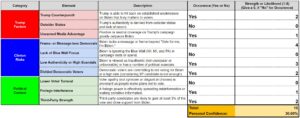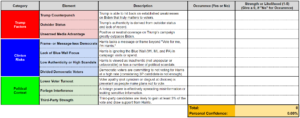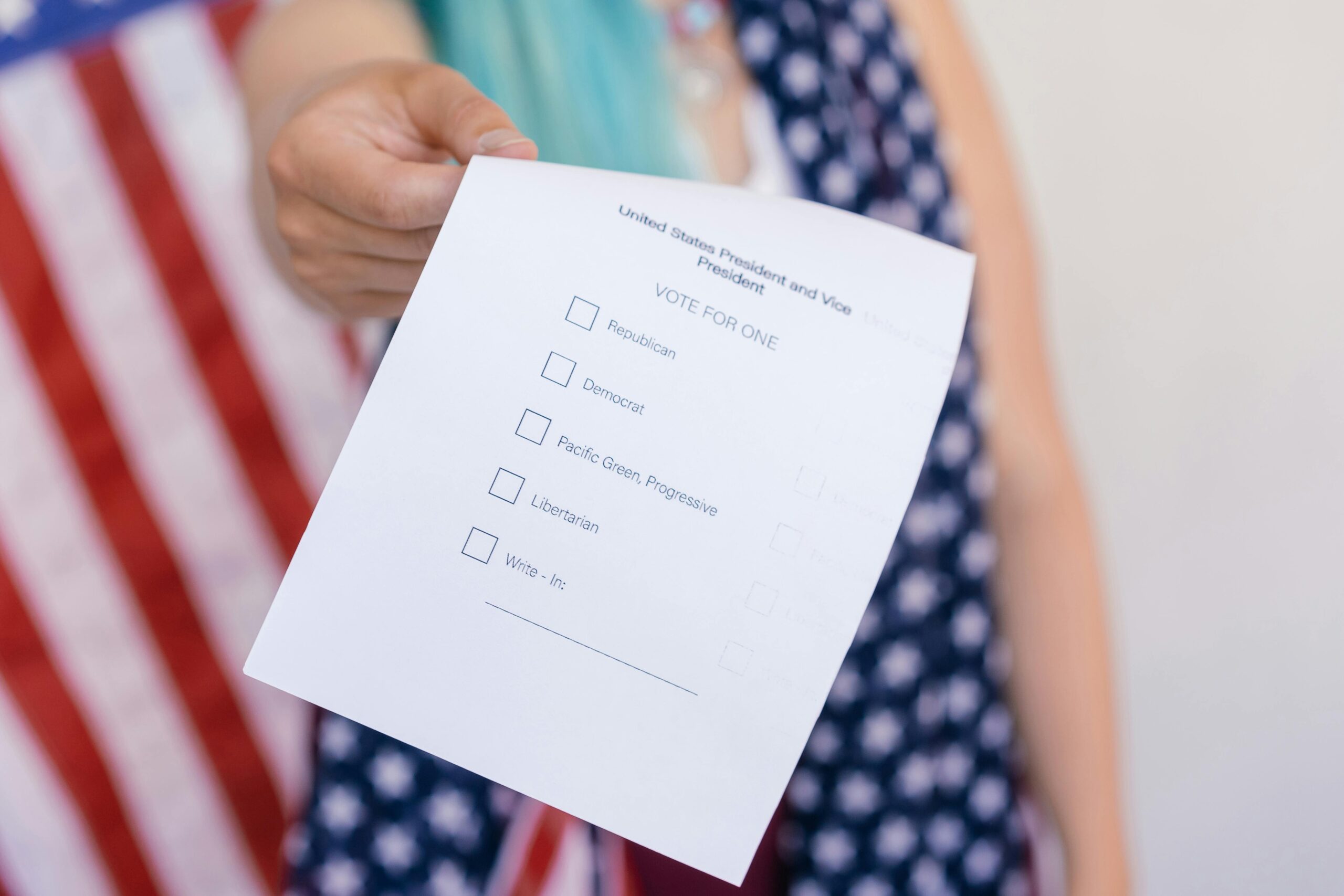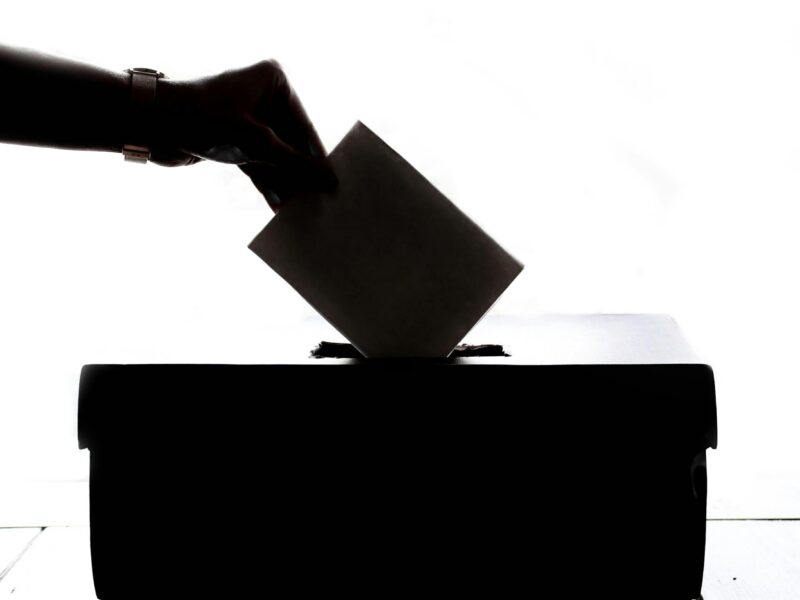After a bit of a break, I’m back. And I missed quite a bit. For starters, Trump has had attempts on his life. President Joe Biden dropped out of the race after a poor debate performance. RFK Jr., a third-party candidate, dropped out and lent his support to Trump. And finally, Vice President Kamala Harris became the Democratic nominee, which we can never deny as a major historic moment for our country. This leads me to another historic moment, the Harris-Trump debate on September 10th, which was . . . interesting to say the least.
Now I know what you’re thinking: “Patrick, everything has changed!” And since there’s no longer a Biden angle to this Presidential scenario I need to throw out the old “Can Biden Win?” analysis and rethink the entire race, right? Well, let’s not be too hasty.
Elections can be fluid, dramatic, and extremely high stakes. 2024 has been no different. But sometimes the more things change, the more they stay the same. Let’s not confuse feeling different about the election with the election actually being different. And I think the general tone is that this is now a close race led by Harris.
However, a surface-level “Biden was going to lose, and now Kamala can win” analysis isn’t going to get us closer to any certainty on whether or not Harris will secure a victory in November. To get certainty, we must analyze the trajectory of the race on a deeper level and see if the strategic narrative of this election is trending towards Harris or Trump. And even then, we might not be done (foreshadowing). But we must start somewhere, and the Election Scorecard will once again guide us. With that, let’s dive back in.
How has the election evolved?
One day prior to the debate on June 27th debate this is how I scored the race:

As a reminder, the scorecard is based on a non-exhaustive list of key strategic factors that led to Trump’s 2016 victory. When you apply the scorecard to 2016 and 2020, it comprehensively explains why Joe Biden succeeded, where Hillary Clinton did not, which you can read in a previous post. I further assert Trump must have these elements in his favor to win, including those no longer available to his strategy such as “Outsider Status.”
To use the scorecard, you must first determine whether a specific element is occurring with a “Yes” or “No.” Then, you rate the strength or likelihood of that element on a scale from one to five. If you think a scorecard element is not occurring, then you assign a zero for the strength or likelihood score. A high strength or likelihood score gives more advantage to Trump and vice versa. Take your total strength and likelihood scores and divide by 50. This is your personal confidence score in Trump’s ability to score a 2016-style victory. This number has no statistical meaning or significance. Its main purpose is to guide your personal confidence level. If you have a low personal confidence score and still highly believe Trump will win, then you’ll need to create alternative Trump victory theories that don’t rest solely on the fact that he won in 2016.
For my scorecard, I ended up at 30% before the debate. I’ll admit this was higher than I thought it would be, but I wasn’t exactly losing sleep over it either. Clearly, had I rescored after the debate during the push to remove Biden as the main candidate the score would have gone up. I would have likely given higher scores for “Third-Party Strength,” “Frame- or Message-less Democrats,” and relatedly, “Divided Democratic Voters.”
Now that Biden is officially out we need a brand new scorecard, right? Ok . . . here is your updated 2024 Election Scorecard:

See what I did there? I simply swapped Biden’s name for Harris’. Here’s a link for you to fill out and think through again.
I hope you appreciate my humor in this situation, but my approach should make sense. As much as you may acknowledge it, the Trump elections so far have been about Trump and his ability to create 2016-style win conditions. In future elections without Trump, we might see more balanced dynamics between candidates, which will generate a more balanced approach. And Harris has certainly brought a new dynamic to the race. I don’t want to understate anything about her candidacy, but while she’s running against Trump, large strategic components will still fit into the 2024 Election Scorecard. Therefore, instead of starting from scratch we can use the scorecard to explain how the Democrats have advanced from being slightly behind to having hope that things could turn in their favor.
As you can see . . . significant improvement. Here’s a breakdown of where the improvements occurred:

Here’s the detailed explanation.
Trump Factors:
Trump Counterpunch (Yes, 1):
Honestly, I almost scored this a zero. As I mentioned in a prior post, Trump was struggling to land this with Biden. Let’s also not forget this was during a time when Biden was struggling with his popularity while facing a similar classified documents investigation.
With Harris, there’s an even taller hill. Speaking about the electorate broadly, Harris entered the race with no real pre-existing negative perceptions unlike Clinton in ’16 and Biden in ’24. Voters are still learning about and judging Harris, and this dynamic isn’t giving Trump the same openings he’s had against other opponents.
Of course, the lack of an opening won’t stop Trump from using his primary attack. And Trump has attempted to generate voter demand for his counterpunch via speeches or advertising in a lot of different ways. Allow me to briefly summarize the general exchange.
Harris and Walz called him “weird” and “dangerous” to democracy, and Trump fired back by calling Harris “radical.” Harris talks about the Trump-blocked immigration bill and her “Opportunity Economy,” and he calls her the “Border Czar” while attempting to blame her for the current state of inflation. Harris calls him a “felon” and “fraudster” who has been accused of and found liable for sexual assault while Trump refers to her as a “liar” putting on a façade about her race for the public. For context, Harris is indeed a black woman, but Trump is convinced she’s not. Harris says Trump’s campaign crowd sizes are small, and Trump says that . . . immigrants are eating the cats, dogs, and pets of citizens.
You know, those last two statements really went off the rails in terms of what his counterpunch is supposed to look like. But I guess going off the rails is something one could be prone to when struggling to find an opening.
After all this work, both candidates are tied in the swing states on who voters trust to “get inflation and the cost of living under control”, which reversed a sizable advantage Trump formerly had on the issue.[i] Harris still lags on immigration but has gained meaningful ground on the issue.[ii] And her favorability ratings have taken off.[iii] The race is close, but this is not what it looks like when the Trump Counterpunch works.
Republicans will continue working to generate openings, but the clock is ticking. And absent an October Surprise, which hopefully Democrats dodged with a quick resolution to the longshoreman’s strike[iv] (seriously please don’t let there be any others), I’m not entirely sure where the opening is going to come from.
So, why did I score this element a one? Trump’s trying to land his counterpunch, and per my methodology, the attempt is at least a one. But reasonable minds could differ.
Outsider Status (No, 0): Please see the “Can Biden Win?” post. Still a no.
Unearned Media Advantage (No, 0): In another counterintuitive observation, Trump was getting some amount of an unearned media advantage when he was in court. But Trump successfully delayed all of his other cases until after the election. So, there is nothing for the news to cover but his campaign. Even the Democratic National Convention scored higher ratings than the Republican National Convention.[v] And the debate wasn’t Trump’s best night.[vi]
Clinton Risks:
Frame- or Message-less Campaign (Yes, 1): The risk has dropped significantly here. Because Harris seems to care more about having a message than Biden did. The “Opportunity Economy,” “A New Way Forward,” and my favorite, “We’re Not Going Back” are good slogans for this campaign.[vii] Don’t get me wrong. I don’t think this is peak messaging and framing. I’ve seen a similar approach come up short in my home state of Tennessee in a different context,[viii] but it can work against Trump in this context.
Continuing our theme of counterintuitive observations, The Heritage Foundation provided Harris with the exact policies we’re not going back to in Project 2025. Even if you feel like Harris is light on details, Project 2025 by and large states exactly what she won’t do while in office. She even lets voters contrast her policies and Project 2025 directly on her website. [ix] This combination of messaging appears to be working for now.
Lack of Blue Wall Focus (No, 0)– Per VoteHub, Harris is all over the Blue Wall.[x] She is spending additional time in the Sun Belt (i.e., North Carolina, Georgia, Arizona, and Nevada), but it is not to the detriment of focusing on the Blue Wall. She also hasn’t overextended by trying to expand the swing state map to states like Texas, which will likely become a future swing state.
Low Authenticity or High Scandals (Yes, 2): Harris’ favorability ratings have only increased with her candidacy.[xi]
Divided Democratic Voters (No, 0): Arguably, it should have happened. This is what had me initially opposing Biden dropping out. At the time, Democratic Party leaders were considering an open convention or a mini-primary.[xii] This would have led to potential ballot access issues in Ohio and Michigan.[xiii] If someone besides Harris had won, then fundraising would have had to start over.[xiv] Additionally, a contested nomination process could have re-opened the ongoing left versus moderate divide.[xv] The fact this didn’t happen is a major boost to Harris’ campaign. But as I mentioned in the previous post, no one unites the Democrats like Donald Trump, and the consolidation around Harris was swift. And just so we’re clear, I voted early for her too.
I’m not saying everyone in the Democratic Party is or should be doing backflips over Harris, but at this time, this factor appears to have no impact on the trajectory of the election.
Political Context:
Lower Voter Turnout (No, 0): There is still no indication that turnout will be low. While 2020 turnout might not be possible, it still doesn’t look like it will be 2016 either.[xvi]
Foreign Interference (Yes, 1): It’s happening. But it doesn’t appear to be like it was 2016 because the intelligence community is more aware and active in its response.[xvii]
Third-Party Strength (Yes, 1): Based on observation of national polls, third-party polling is all over the place. However, it still seems more likely to hinder than help Trump if third-party candidates gain steam.[xviii] And it seems like a lot of pollsters are happy to survey this as a two-person race now.
So, What Happened Here?
You might be thinking, “So, Biden was going to lose, and Harris could win. Thanks.” First, both could have won, and I’ll be standing by that conclusion. But as mentioned above, we really need to understand what is happening to gain any certainty in answering whether Harris will win this election.
If Biden’s candidacy continued beyond July, I would have been tracking voter reversion in key Democratic Party voting blocks. Per the Let’s Talk Elections (“LTE”) YouTube channel, as voters get more engaged during elections there is a tendency to revert back to how they voted in prior presidential elections.[xix] In April, LTE asserted voter reversion as a rationale for an increase in polling performance for Biden.[xx]
Over that summer, I would have been looking for this voter reversion in polling, specifically among women, minorities, and younger voting blocks, to see if they were trending back toward Biden. If this reversion happened with enough force Biden would have regained an advantage. If it didn’t, then I give us all permission to freak out! Especially if it hadn’t happened by September or October.
In my scorecard, voter reversion would have improved some key elements. Hopefully, as we closed in on Election Day, I would have been scoring downward the “Divided Democratic Voters” and likely the “Frame- or Message-less Campaign” factors, as I would expect a Biden Democratic National Convention to establish some attempt at a unified message to further induce voter reversion. And finally, effective messaging would have decreased the “Trump Counterpunch” element for Biden.
Now, let’s look again at my 2024 Election Scorecard changes again:

The scorecard reflects that Harris triggered this voter reversion earlier than Biden could have, if it was ever going to happen.
My scorecard changes are not the only evidence of voter reversion. About a month after Harris ascended to the top of the ticket, The Cook Political Report released polling showing Harris had significantly narrowed Trump’s previously large margins with low/mid-engagement voters and new registrants.[xxi] Specifically, the low/mid-engagement voters tend to be more female, more minorities, and younger, which “all [are] characteristics that would seem to suggest upside for Democrats.”[xxii] Combine this with Harris’ advantage with high-engagement voters, and you have the “close but slightly favoring Harris” election dynamics we have today. And I have one less thing on my to-do list for this election. Therefore, it is true. Harris (or at least the change away from Biden, who was doing terribly with low/mid-engagement and new voter blocks) activated people. But the key is that activation was broader than just exciting the rank-and-file Democrats.
Whether this reversion would have happened for Biden and carried him to victory is now the subject of historical debate and speculation. I certainly have my thoughts on it. And maybe I’ll attend someone’s presentation on the topic at Biden’s future presidential library. But now people can feel like they are supporting their candidate rather than reverting to Biden out of fear for Trump.
Now that the reversion has occurred, will it carry Harris to victory? Per the scorecard, her odds of a 2016-style upset are low by my estimation, which is good for a woman presidential nominee who seems to have the lead.
However, did you notice how much polling data I had to rely on to get to these conclusions? I know a lot of you are skeptical about polling data, and I certainly think the polls require more scrutiny than ever. Therefore, before giving you a yes or no . . . I need to take a closer look at these polls.
And because that analysis would make this post too lengthy, I’m going to have to make this The Real Question’s first two-parter. So, be on the lookout for “Will Kamala Harris Win? Pt. 2 (Polling Analysis Edition)”.
Update: This post was updated on 11/5/24 to fix a prior typo where “(No, 0)” was written to “Low Authenticity or High Scandals.” The correct score is up now. The score is reflects the general risk for all politicians with authenticity and scandal.
Endnotes:
[i] https://www.cookpolitical.com/sites/default/files/2024-10/SSPSlide10.pdf
[ii] https://www.cookpolitical.com/sites/default/files/2024-10/SSPSlide10.pdf
[iii] https://projects.fivethirtyeight.com/polls/favorability/kamala-harris/
[iv] https://www.cnbc.com/2024/10/03/port-strike-ends-as-workers-agree-to-tentative-deal-on-wages-and-contract-extension.html
[v] https://www.newsweek.com/dnc-tv-ratings-compared-rnc-1942197
[vi] https://www.cnn.com/2024/09/11/politics/harris-trump-debate-analysis/index.html
[vii] https://kamalaharris.com/ (The messaging is all throughout the campaign site.) https://kamalaharris.com/issues/ ; https://www.youtube.com/watch?v=GaBfFIsoJ0c ; https://apnews.com/article/kamala-walz-vp-weird-trump-gen-z-f9d718890c3ca907f42dba5934075382
[viii] https://www.pbs.org/newshour/politics/politics-july-dec06-tnsen_11-08
[ix] https://kamalaharris.com/issues/
[x] https://analysis.votehub.us/pages/presidential-campaign-events-tracker
[xi] https://projects.fivethirtyeight.com/polls/favorability/kamala-harris/
[xii] https://www.politico.com/news/2024/07/03/clyburn-biden-president-election-dnc-00166481 ; https://www.cbsnews.com/news/what-is-an-open-convention/
[xiii] https://www.politico.com/live-updates/2024/07/21/joe-biden-drops-out-election/gop-legal-challenges-00170014 ; https://newrepublic.com/post/184042/aoc-alexandria-ocasio-cortez-warning-biden-drop-out-instagram-live ; https://www.rollingstone.com/politics/politics-news/aoc-biden-instagram-live-1235063999/ (Here’s AOC really laying out all the logistical concerns.)
[xiv] https://youtu.be/Aj8lwyWKpa4?feature=shared (Here’s video generally about Harris’ fast start that covers this topic.)
[xv] https://asktherealquestion.com/why-do-progressives-lose-primaries/
[xvi] https://www.npr.org/2024/03/19/1238646047/voting-options-early-mail-ballots ; https://news.gallup.com/poll/645101/thought-given-election-portends-high-turnout.aspx ; https://nymag.com/intelligencer/article/2024-turnout-apathy-biden-trump.html ; https://www.usatoday.com/story/news/politics/elections/2024/05/14/2024-election-voter-turnout-study/73683077007/
[xvii] https://www.whitehouse.gov/briefing-room/presidential-actions/2024/09/09/press-release-notice-on-the-continuation-of-the-national-emergency-with-respect-to-foreign-interference-in-or-undermining-public-confidence-in-united-states-elections-2/#:~:text=Although%20there%20has%20been%20no,free%20and%20open%20political%20system. ; https://www.politico.com/news/2024/09/07/foreign-influence-2024-election-00177828
[xviii] https://projects.fivethirtyeight.com/polls/president-general/2024/national/
[xix] https://www.youtube.com/watch?v=_a5zRhv086k
[xx] https://www.youtube.com/watch?v=_a5zRhv086k
[xxi] https://www.cookpolitical.com/analysis/survey-research/2024-swing-state-project/secret-harris-recipe-narrowing-trumps-lead-low?check_logged_in=1
[xxii] https://www.cookpolitical.com/analysis/survey-research/2024-swing-state-project/secret-harris-recipe-narrowing-trumps-lead-low?check_logged_in=1



